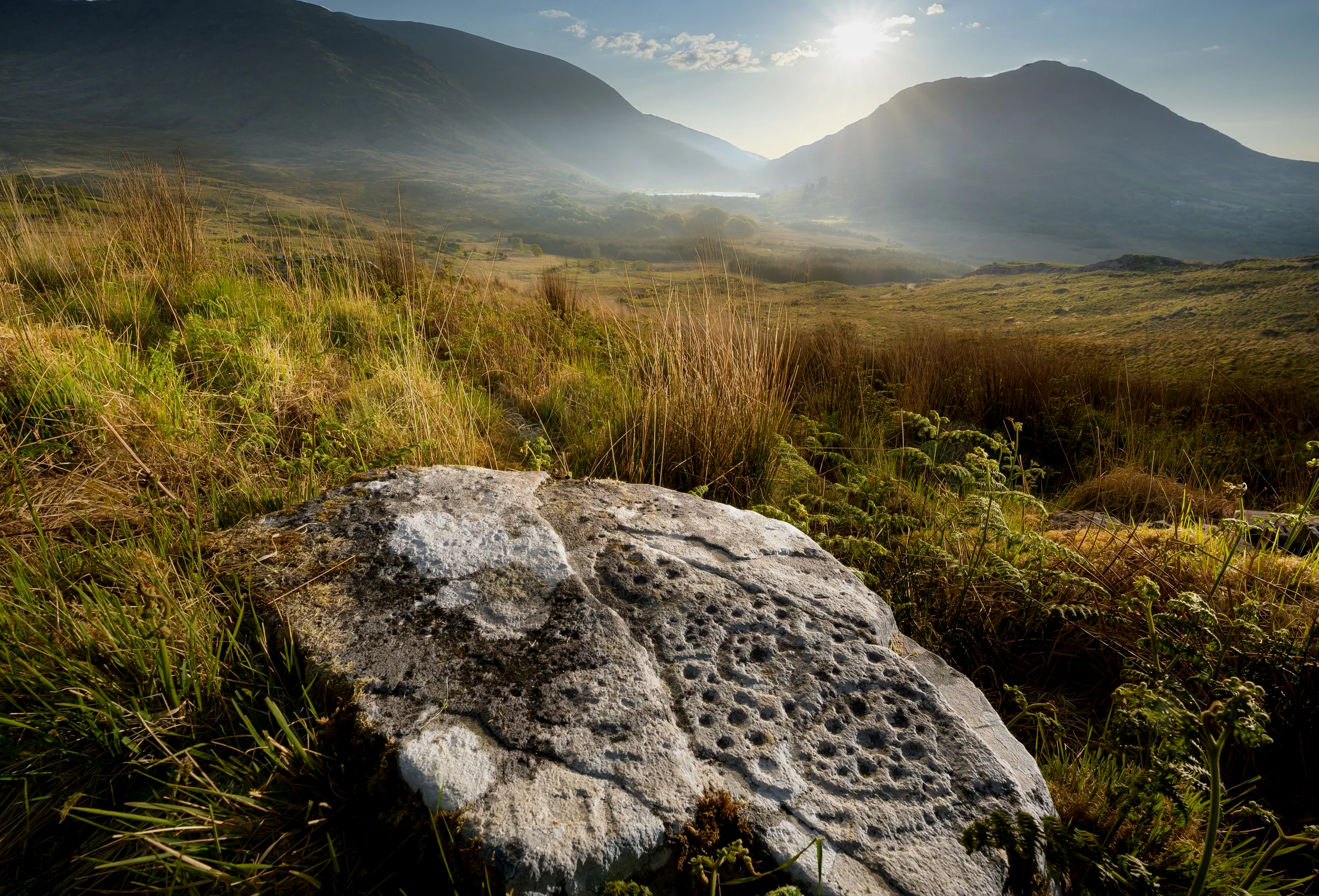The Mist Filled Path: Shadow Work, Trauma and the Tuatha Dé Danann
Shadow Work, Trauma and the Tuatha Dé Danann - The Supernatural Race in Irish Mythology
“They brought a darkness over the sun for three days and three nights... They burned their fleet of ships that they should not think of retreating to them, and the smoke and the mist that came from the vessels filled the neighbouring land and air....”
Lady Augusta Gregory
Ceo, is the Irish word for fog or mist. Mist or fog has long served as a potent symbol in Irish myth and folklore, evoking a sense of mystery, uncertainty, concealment, and transformation. In Irish mythology, the Tuatha Dé Danann — a race of semi-divine beings — are said to have arrived in Ireland shrouded by a magical mist (MacKillop, 2004). This mist rendered them invisible, cloaking their entry to Ireland so humans could not see them. Symbolically, fog marks a threshold space, concealing and revealing, signalling the presence of the Otherworld.
The Tuatha Dé Danann themselves embody liminality. Positioned ambiguously between gods and mortals, they dwell in sídhe mounds, under the earth. As Proinsias Mac Cana (1983) notes, mist often signals the permeability of worlds, where the natural and supernatural intermingle. It marks a liminal threshold space.
The Shadow
In psychology, liminal threshold spaces are often charged with energy. In all of us, there is a world that is conscious to us and a world that is out of our awareness – an inner realm, the unconscious, or what Carl Jung called the shadow. This is a reservoir of feelings, thoughts, images, symbols, urges and memories that are outside of our conscious awareness. A repository of those aspects of the self which are denied or disowned in our development as a way to fit in.
Jung believed that the unconscious played a crucial role in shaping personality. The shadow harbours our blind spots. It teaches us where we need to develop and mature. It conceals reserves of untapped power and vitality that we are completely unfamiliar with. Something that may seem quite remote from our present awareness can, in fact, be playing out within us and may produce a familiar pattern, although we may not recognise it at the time.
Shadow work refers to the process of encountering, integrating, and transforming these hidden elements, so that we are more whole.
Here is why it matters:
Self-Awareness – By recognizing hidden patterns, you understand why you react, think, or feel the way you do.
Emotional Healing – Suppressed emotions often show up as stress, anxiety, or unhealthy behaviors and physical symptoms. Facing them directly helps release and heal.
Healthier Relationships – When you project your shadow onto others, it can cause conflict. Shadow work reduces projection, leading to more authentic connections.
Personal Growth – Accepting your whole self (both “light” and “dark”) builds resilience, confidence, and authenticity.
Empowerment – Instead of being controlled by unconscious impulses, you gain choice and freedom in how you act.
In addition to the Personal Unconscious, there is what Jung referred to as the Collective Unconscious. This contains inherited ancestral memories common to all of humankind. The collective unconscious images possess a mythic and primordial quality. These primordial images, Jung says, “are the deepest, the most ancient and the most universal thoughts of humanity.”
Trauma and the Unconscious
Trauma deepens the repression of those inner elements because the psyche is trying to cope with intolerable experience by pushing it into the unconscious as a protective strategy, creating what Judith Herman (1992) calls a “double life” of dissociated states. Trauma, in essence, is an overwhelming event, or series of events, that were too much for us to metabolise, so the aspects of that experience were repressed. As Bessel van der Kolk (2014) observes, traumatic memory is often fragmented and nonlinear, surfacing not as a narrative but as sensations, flashbacks, or silence. The fog, then, becomes both a metaphor and a lived experience of trauma: a disorientation of perception, memory, and identity. The metaphorical fog, in this sense, is not accidental but defensive, a psychic veil that conceals both pain and potential.
Embarking on the mist-filled path, or entering the metaphorical fog, becomes an act of shadow work. To approach what has been hidden is to accept liminality: the state of being “betwixt and between,” as Victor Turner (1969) famously described in his anthropology of ritual. In liminal space, ordinary boundaries dissolve; one’s sense of self, time, and place is suspended. Just as fog erases the horizon, shadow work requires the subject to relinquish certainty, moving slowly through ambiguity.
Yet the Otherworld is not solely a place of danger; it is also a site of gift. The Tuatha Dé Danann bring with them treasures — magical cauldrons, spears, and stones — symbols of healing, artistry, and sovereignty (Gray, 1982). Likewise, the unconscious contains not only wounds but also resources, such as creativity, resilience, and forgotten aspects of one’s identity. Shadow work reveals what trauma conceals not just the wounding but also capacities and gifts, in each individual, that may be reintegrated into the self.
The fog is thus paradoxical. It disorients and protects, obscures and invites. The fog of the Tuatha de Danann enacts this duality: it both conceals their presence and signals that something extraordinary is near. To step into the fog is to accept both risk and potential, to confront that which resists clarity.
Integration and Wholeness - The Healing of Trauma
Jung emphasised that individuation — the process of becoming whole — is not a conquest of the unconscious but an ongoing dialogue with it. Similarly, trauma therapy recognises that healing is to weave fragmented memory into narrative without forcing resolution (Herman, 1992; Ogden, Minton, & Pain, 2006). To allow those exiled parts to return, to be grieved and met and thereby, welcomed home.
The Tuatha Dé Danann, arriving to Ireland in their otherworldly fog, symbolise the threshold quality of the unconscious: frightening, alluring, numinous and transformative. To engage in shadow work is to follow them into that liminal space, to risk the disorientation of the Otherworld to return with gifts. The fog, then, is not merely an obstacle but a guide — a reminder that what is hidden is also what has the power to heal.
You are invited to join me for a 4-hour live online workshop experience, where we will explore the path of transformation through the mist to the inner world.
Upcoming Workshop
Embarking on the Mist Filled Path
Sunday 19th October 2025
9 am (PST) | 5 pm (Irish Standard Time)
The Gaelic Otherworld was a realm beyond linear time, woven into the fabric of everyday life for our Irish ancestors. It was a parallel world inhabited by the Aos Sí, (the faeries). We explore these ancestral tales and mythic roots, immersing ourselves in the realm of the sidhe, Tír na nÓg, ("Land of Eternal Youth"), faerie encounters, sacred wells, rituals, charms, prayers and landscape—not just as folklore, but as symbolic gateways into our own depths, our own hidden inner world.
References
Gray, E. (1982). Cath Maige Tuired: The second battle of Mag Tuired. Irish Texts Society.
Herman, J. L. (1992). Trauma and recovery: The aftermath of violence—From domestic abuse to political terror. Basic Books.
Jung, C. G. (1968/1959). Aion: Researches into the phenomenology of the self (Collected Works Vol. 9, Part II, R. F. C. Hull, Trans.). Princeton University Press.
Mac Cana, P. (1983). Celtic mythology. Hamlyn.
MacKillop, J. (2004). Dictionary of Celtic mythology. Oxford University Press.
Ogden, P., Minton, K., & Pain, C. (2006). Trauma and the body: A sensorimotor approach to psychotherapy. W. W. Norton & Company.
Turner, V. (1969). The ritual process: Structure and anti-structure. Aldine.
van der Kolk, B. (2014). The body keeps the score: Brain, mind, and body in the healing of trauma. Viking.




